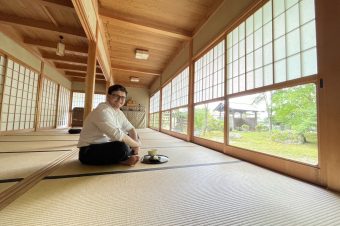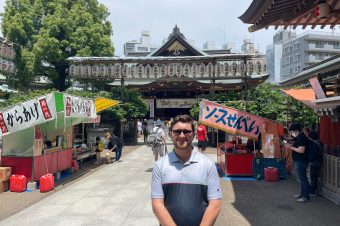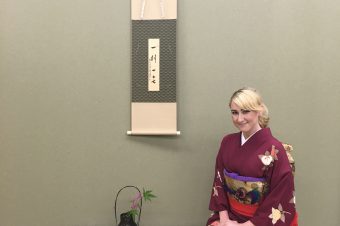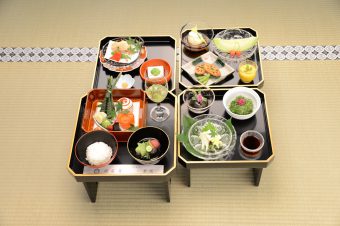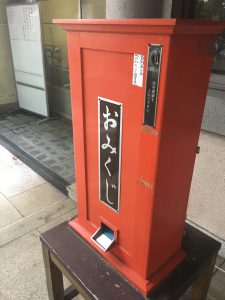 On a patron’s first visit to a temple or shrine of the year, called the “hatsumode,” many people purchase an omikuji. An omikuji is a little strip of paper that tells the patron their fortune for the year. Omikuji are purchased during other times as well, mostly during big milestones in someone’s life, such as before marriage, before an exam, before a new job, etc. Typically, an omikuji costs around 100-200 yen (1-2 USD) and can be purchased through a few different methods. One of the most common methods includes selecting a thin stick from a container. These sticks are numbered and coordinate with numbered drawers. Based upon which stick the patron chooses, they will take one omikuji from that drawer (all of the omikuji in a single drawer are identical). Other than this method, some places sell omikuji in cute containers and some dispense them from vending machines. Several shrines will offer specialized omikuji, focusing on things such as love, or written in a foreign language (most commonly English or Chinese).
On a patron’s first visit to a temple or shrine of the year, called the “hatsumode,” many people purchase an omikuji. An omikuji is a little strip of paper that tells the patron their fortune for the year. Omikuji are purchased during other times as well, mostly during big milestones in someone’s life, such as before marriage, before an exam, before a new job, etc. Typically, an omikuji costs around 100-200 yen (1-2 USD) and can be purchased through a few different methods. One of the most common methods includes selecting a thin stick from a container. These sticks are numbered and coordinate with numbered drawers. Based upon which stick the patron chooses, they will take one omikuji from that drawer (all of the omikuji in a single drawer are identical). Other than this method, some places sell omikuji in cute containers and some dispense them from vending machines. Several shrines will offer specialized omikuji, focusing on things such as love, or written in a foreign language (most commonly English or Chinese).
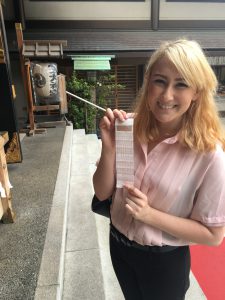 The first thing a person checks for on their omikuji is the level of luck they received. Their luck can range from daikyo (very bad luck), to kyo (bad luck), to kichi (good luck), to daikichi (very good luck) and sometimes even levels between these. The rest of their fortune will correspond with this level of luck and will provide details about many areas of interest such as health, education, success, and love. If a patron is unhappy with the fortune that they receive, such as if they receive one with bad luck, they may tie their paper to either a pine tree or fence. Traditionally, only pine trees were used, but many shrines now provide a fence in order to protect the trees from harm. The idea of tying the omikuji to pine trees comes from the fact that the word for “pine” in Japanese is “matsu” and the word for “wait” in Japanese is also “matsu.” Therefore, by tying the fortune to the tree, you are leaving your bad luck there to “wait,” rather than follow you home. This is the reasoning behind some shrines selling omikuji inside of cute containers. If the patron has to leave their fortune behind, this way they can keep their container as a souvenir and not feel like they wasted their money.
The first thing a person checks for on their omikuji is the level of luck they received. Their luck can range from daikyo (very bad luck), to kyo (bad luck), to kichi (good luck), to daikichi (very good luck) and sometimes even levels between these. The rest of their fortune will correspond with this level of luck and will provide details about many areas of interest such as health, education, success, and love. If a patron is unhappy with the fortune that they receive, such as if they receive one with bad luck, they may tie their paper to either a pine tree or fence. Traditionally, only pine trees were used, but many shrines now provide a fence in order to protect the trees from harm. The idea of tying the omikuji to pine trees comes from the fact that the word for “pine” in Japanese is “matsu” and the word for “wait” in Japanese is also “matsu.” Therefore, by tying the fortune to the tree, you are leaving your bad luck there to “wait,” rather than follow you home. This is the reasoning behind some shrines selling omikuji inside of cute containers. If the patron has to leave their fortune behind, this way they can keep their container as a souvenir and not feel like they wasted their money.
Another popular tradition at shrines is the use of ema. Ema are wooden plaques that are used for wishing. Ema can sometimes be found at temples, as well, due to Japan’s close ties between the two.
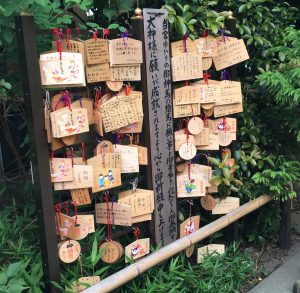 The origin of ema dates back to the Nara Period, when horses were thought of as the vehicle that gods took to travel to and from the human realm. Therefore, many people donated horses to shrines as an offering to the gods. Sadly, many people were too poor to be able to donate horses, so many people donated wood, clay or paper statues that resembled horses instead. Eventually, this tradition evolved into wooden plaques with a horse picture on them, resembling the ones that are used today. This explains why the word “ema” is made up of two Kanji, one meaning “picture” and the other meaning “horse.”
The origin of ema dates back to the Nara Period, when horses were thought of as the vehicle that gods took to travel to and from the human realm. Therefore, many people donated horses to shrines as an offering to the gods. Sadly, many people were too poor to be able to donate horses, so many people donated wood, clay or paper statues that resembled horses instead. Eventually, this tradition evolved into wooden plaques with a horse picture on them, resembling the ones that are used today. This explains why the word “ema” is made up of two Kanji, one meaning “picture” and the other meaning “horse.”
Nowadays, ema have an infinite number of pictures and designs on them. The tradition grew from only horses, to zodiac animals, to gods and spirits, and now to popular anime and pop-culture characters.
Essentially the way ema work is that people purchase one for about 500-1000 yen (5-10 USD) and decide if they want to leave it at the shrine/temple or take it home as a souvenir. If they decide to leave it at the shrine/temple, the person writes a wish on the back. 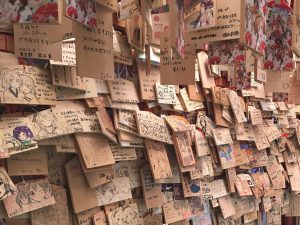 The most common wishes are for exam success, sports success, health, love, safe childbirth, and weight loss. Wishes for exam success is definitely the most popular and you can see shrines/temples crowded with students writing on ema right before exams. Typically, these students will visit a Tenmangu Shrine, as they are the ones specifically related to academic success.
The most common wishes are for exam success, sports success, health, love, safe childbirth, and weight loss. Wishes for exam success is definitely the most popular and you can see shrines/temples crowded with students writing on ema right before exams. Typically, these students will visit a Tenmangu Shrine, as they are the ones specifically related to academic success.
Another common way of writing wishes is by writing yojijukugo, or four-character phrases. These phrases include kanai anzen (safety for one’s family), shobai hanjo (prosperity in business), kenko kigan (prayer for health) and ren-ai joju (romantic success).
Many people tend to confuse ema and omikuji, despite the fact that they are drastically different. When deciding which to purchase, consider the following: Does the shrine offer omijkuji in your language? If not, can you or a friend read Japanese? The Japanese that is used to write omikuji is very difficult, so consider this carefully. Also, the price difference is quite significant between the two. How much are you willing to spend? Finally, omikuji is for telling you what your luck will be, while ema is for wishing for something that you decide yourself. Therefore, are you looking for insight on your future or is there something specific that you would like to wish for?
If you are visiting Japan for the first time, I would suggest to try both ema and omikuji. Since these two things are very different from each other, it is fun to experience both. If you find an ema that particularly strikes your fancy, purchase it to take as a souvenir! And do not fear- if you get an unlucky omikuji, you can always tie it there. Good luck and may all your wishes come true.
